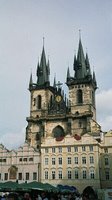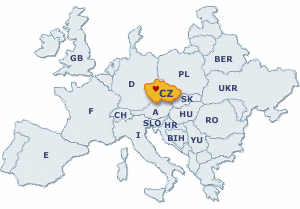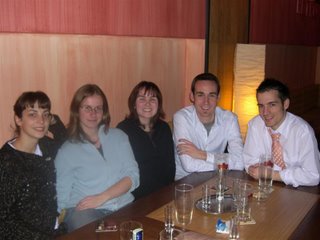 Well, I am about to finish my work here in Prague, and to celebrate my birthday and my farewell, my boss and a few IAESTE members took me out for dinner and a few drinks.
Well, I am about to finish my work here in Prague, and to celebrate my birthday and my farewell, my boss and a few IAESTE members took me out for dinner and a few drinks. Dinner consisted of cheese gnocchi and beer, and Janca suggested a round of Becherovka, the
 green bottle in the picture, which is a Czech herbal bitter liqueur, also know as "medicine" here by many former communists. It was a lovely shot, smooth and chilled, and welcomingly cleansed my palette. As a birthday/departing gesture, I was given the typical Czech sugar wafers, a bottle of Becherockva, and a large bar of Studentksá chocolate, which I was informed, is good for students to eat while studying for increased energy (After a later discussion this Alberto, apparently, his knows of students in Italy who always study with chocolate in hand as well).
green bottle in the picture, which is a Czech herbal bitter liqueur, also know as "medicine" here by many former communists. It was a lovely shot, smooth and chilled, and welcomingly cleansed my palette. As a birthday/departing gesture, I was given the typical Czech sugar wafers, a bottle of Becherockva, and a large bar of Studentksá chocolate, which I was informed, is good for students to eat while studying for increased energy (After a later discussion this Alberto, apparently, his knows of students in Italy who always study with chocolate in hand as well).
 a primitive planetarium, displaying the current state of the universe, and dates back to 1410. The astronomical dial has a background that represents the standing Earth and sky, and surrounding it operate four main moving components: the zodiacal ring, an outer rotating ring, an icon representing the Sun, and an icon representing the Moon. Quite impressive!
a primitive planetarium, displaying the current state of the universe, and dates back to 1410. The astronomical dial has a background that represents the standing Earth and sky, and surrounding it operate four main moving components: the zodiacal ring, an outer rotating ring, an icon representing the Sun, and an icon representing the Moon. Quite impressive!We then nestled ourselves in a little, neat literary-themed, Czech café with
 Czech poems and phases written on the walls. We probably were the only Expats there since the entrance with its humble, brown, wooden door, lost in the grandeur of Old Town Prague, is easily passed by a busy tourist. First the first time in Europe this trip, I was able to recharge with a Macchiato Latté.
Czech poems and phases written on the walls. We probably were the only Expats there since the entrance with its humble, brown, wooden door, lost in the grandeur of Old Town Prague, is easily passed by a busy tourist. First the first time in Europe this trip, I was able to recharge with a Macchiato Latté.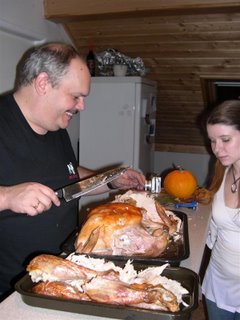




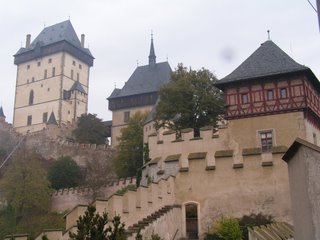

 Here is a picture of Graham enjoying a little mediaeval expereince.
Here is a picture of Graham enjoying a little mediaeval expereince.


